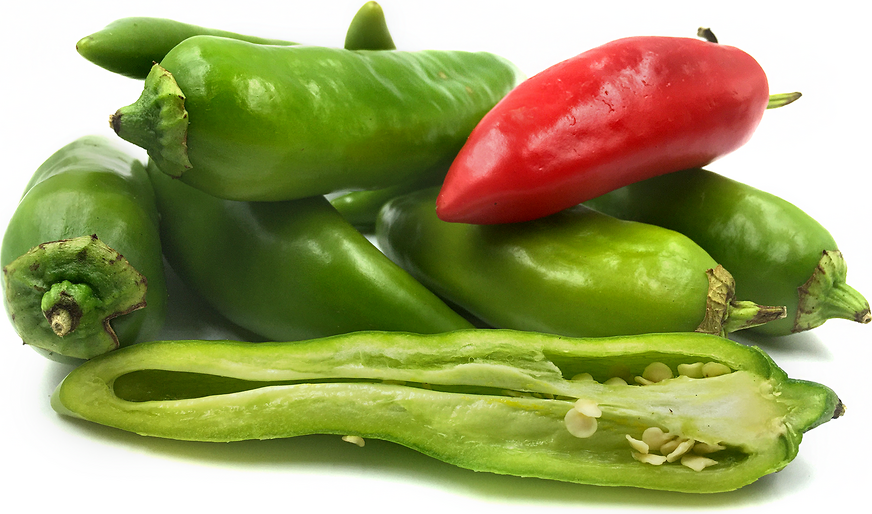


Highlander Hot Chile Peppers
Estimated Inventory, lb : 0
Description/Taste
Highlander Hot chile peppers are elongated, flattened pods, averaging 17 to 20 centimeters in length and 5 to 7 centimeters in diameter, and have a conical shape with slight tapering to a rounded point on the non-stem end. The semi-thick skin is smooth, glossy, and waxy, ripening from green to bright red when mature. Underneath the skin, the thick, pale green flesh is crisp, aqueous, and faintly striated, encasing a central cavity filled with white membranes and many round and flat, cream-colored seeds. Highlander Hot chile peppers have a crunchy consistency and an earthy, pungent, and subtly acidic taste with a moderate spice that does not linger on the palate.
Seasons/Availability
Highlander Hot chile peppers are available in the summer through fall.
Current Facts
Highlander Hot chile peppers, botanically classified as Capsicum annuum, are a hybrid variety of the Anaheim pepper that belongs to the Solanaceae or nightshade family. Developed at the Chili Pepper Institute of New Mexico to have improved growth habits in cooler temperatures, Highlander Hot chile peppers were also hand-selected for their mild heat, elongated shape, and early ripening time. Highlander Hot chile peppers range 1,000-1,500 SHU on the Scoville scale and are popularly consumed in their immature green state, often used in any recipe calling for Anaheim chile peppers. The peppers are not commercially grown, but they have become a prevalent variety cultivated in home gardens and through specialty farms.
Nutritional Value
Highlander Hot chile peppers are an excellent source of vitamins A and C, which are antioxidants that can help protect the body from external environmental aggressors and boost the immune system. The peppers also contain vitamins B6 and K, potassium, and fiber.
Applications
Highlander Hot chile peppers are best suited for both raw and cooked applications such as roasting, grilling, and baking. The peppers are often used in their immature green state when the pepper has a milder flavor, but they can also be used in their mature red state. The most popular preparation method is to fire roast the pepper until the skin is charred and then remove the skin to reveal tender, flavorful flesh. Once the pepper is cooked, it can be chopped into salsas and sauces, served with egg or potato dishes, sliced into soups and stews, tossed into pasta, or layered over tacos and nachos. Highlander Hot chile peppers can also be stuffed with meat and cheese, dipped in egg, and then fried to make a version of chile relleno. Highlander Hot chile peppers pair well with meats such as pork, poultry, and beef, eggs, potatoes, corn, tomatoes, black beans, rice, spices such as cumin and coriander, cilantro, pineapple, mango, and avocado. The peppers will keep up to one week when stored whole, unwashed, and loosely placed in a plastic bag in the refrigerator.
Ethnic/Cultural Info
Highlander Hot chile peppers are often labeled as a NuMex variety, which is a general label for cultivars created by the Chile Pepper Institute of New Mexico. The institute is located on campus at New Mexico State University and is one of the only non-profit chile pepper research organizations, currently run by “chileman” Dr. Paul W. Bosland, one of the most well-known and respected pepper experts. Through research and selective breeding, the institute creates varieties that have improved resistance to disease, flavor, and appearance. These peppers are given the NuMex name to signify that they came from the institute and have a reputation for quality and excellent growth habits.
Geography/History
Highlander Hot chile peppers are a hybrid variety developed by the Chile Pepper Institute of New Mexico and were then field-tested at Johnny’s Seeds in Maine. Bred for the cooler climates of North America, Highlander Hot chile peppers are not grown commercially, but are available through online seed catalogs for home garden use and may be found at local farmers markets.




